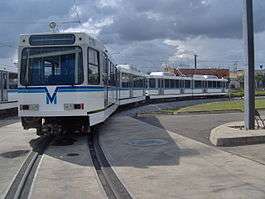Valencia, Carabobo
Valencia (Spanish pronunciation: [baˈlensja]) is the capital city of Carabobo State and the third-largest city in Venezuela.
Valencia | |
|---|---|
| Nuestra Señora de la Asunción de la Nueva Valencia del Rey | |
.jpg) Flag | |
| Etymology: Valencia de Don Juan | |
| Nickname(s): Capital industrial de Venezuela, La pequeña Detroit (The little Detroit), La ciudad de las naranjas, La ciudad de las mujeres hermosas, Valencia señorial | |
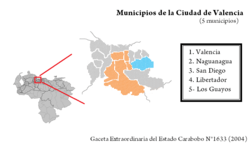 | |
.svg.png) Valencia | |
| Coordinates: 10°11′N 68°00′W | |
| Country | |
| State | Carabobo |
| Municipality | Valencia Libertador Los Guayos Naguanagua San Diego |
| Founded | March 25, 1555 |
| Area | |
| • Total | 623 km2 (241 sq mi) |
| Elevation | 520 m (1,710 ft) |
| Population (2010)* | |
| • Total | 832,409 |
| Demonym(s) | Valenciano(a) |
| Time zone | UTC-4 (VET) |
| • Summer (DST) | UTC-4 (not observed) |
| Postal code | 2001 |
| Area code(s) | 0241 |
| Climate | Aw |
| Website | alcaldiadevalencia.gob.ve |
| ^* The area and population figures are for the municipality | |
The city is an economic hub that contains Venezuela's top industries and manufacturing companies. The population of Valencia and the nearby metropolitan area reached 1,827,165 in 2010, and it is expected to grow dramatically in the years to come. It is also the largest city in the Valencia-Maracay metropolitan region, which with a population of about 4.5 million is the country's second largest after that of Caracas. Caracas lies some 172 kilometres (107 miles) away to the east.
History
The area was already inhabited in the fourth millennium BC. The inhabitants were mainly hunters and gatherers who might have already developed some elementary forms of agriculture. Between AD 200 and 1000 an important settlement was formed close to Lake Valencia.
Around the year 1000, waves of migration started to come from the Orinoco river area, probably arriving along the Pao river. The fusion of previous settlements with these new populations gave rise to the Vacencioide culture.[1][2]
People in the area belonged mostly to Arawak groups. They were hunters and gatherers who also fished and grew maize and cotton. Their houses were built on artificial mounds in valleys that were often flooded by water from Lake Valencia.
Archaeologists have found mostly pottery from that time. Valencia was founded by Captain Alonso Díaz Moreno on March 25, 1555 – as the locals are proud of reminding visitors, eight years before Caracas. It was the first Spanish settlement in central Venezuela and its official name was Nuestra Señora de la Asunción de Nueva Valencia del Rey. It was named after Valencia de Don Juan, Province of León, Spain. The encomiendas put the Indians living in the region under the control of the Spanish settlers. They started to displace the native population from the most fertile land, but they also started intermarrying with them.
Spanish conquistador Lope de Aguirre entered the city in 1561. In 1677 it was raided by French pirates, who burnt down its City Hall, thus destroying many very important documents about the early settlement of Venezuela. The German scientist Alexander von Humboldt visited the city on his trip through the Americas. He reported that at the time of his visit the city had around 6000 to 7000 inhabitants. On June 24, 1821, the battle of Carabobo was fought on the outskirts of the city, sealing the independence of Venezuela from imperial Spanish rule.
Valencia became the capital of Venezuela in 1830, after it separated from Gran Colombia. It ceased to be the capital soon afterward, becoming once more the seat of the national government in 1858 after the Monagas was toppled and the March Revolution took place. On November 15, 1892, the University of Valencia, future University of Carabobo, was founded. When dictator Juan Vicente Gómez died in 1935, Nueva Valencia del Rey was a small city. The oil revenues and industrialization that came along lead to a population explosion. Many immigrants, firstly from Europe and increasingly then from other Latin American countries, chose Nueva Valencia del Rey as the place to live in Venezuela.
The first direct election of local governments (including those of the mayor and of the state's government) took place in 1988.
Valencia was one of the places where Hugo Chávez's proposal for the constitutional reform was rejected with the highest proportion of votes: around 59.21% of the population rejected it.[3] An Italian tribunal ruled that physicist Ettore Majorana who disappeared in 1938 was living in Valencia during the late Fifties. See here:
Geography
Valencia is located in a central valley, surrounded by a mountain range called the Coastal Range (Cordillera de la Costa). On the eastern outskirts of the city lies Lake Valencia, Venezuela's second-largest lake. To the West and Northeastern part there are mountains. To the south is an extension of the Venezuelan grasslands, the Llanos.
The elevation of the city is 520 metres (1,710 feet).
Climate
Valencia, due to its latitude and closeness to the sea, has relatively warm temperatures. The yearly average is 26 °C (79 °F), (23.3 °C (73.9 °F) in the shade, a maximum of 32.6 °C (90.7 °F) and minimum of 18.5 °C (65.3 °F)). The city is located 479 metres (1,572 feet) above sea level. Winds reduce the temperature in the afternoon.
Environment
The Cabriales river has problems with pollution. The most important waste disposal centre of Greater Valencia and Carabobo is located southwest of Valencia proper, in the Municipio Libertador, in La Guásima. There, waste is basically burnt without any special equipment.[4]
Demography
City of Valencia Municipalities[5]
| Municipality | Capital | Est. population[6] | km2 | Population Density (inhabitants/km2) | Parishes |
|---|---|---|---|---|---|
| Valencia | Valencia | 832,409 | 623 | 1348.2 | Candelaria, Catedral, El Socorro, Miguel Peña, Rafael Urdaneta, San Blas, San José, Santa Rosa, Negro Primero |

Law and government
The City of Valencia is made of five (5) municipalities:[7] Valencia, Libertador, Los Guayos, Naguanagua, and San Diego.
Venezuelan law specifies that every municipal government must have four main functions: executive, legislative, comptroller, and planning. The executive function is managed by the mayor of each municipality, who is in charge of representing the municipality's administration. The legislative branch is represented by the Municipal Council, composed of seven councillors for each municipality, charged with the deliberation of new decrees and local laws. The comptroller tasks are managed by the municipal comptroller's office, which oversees accountancy. Finally, planning is represented by the Local Public Planning Council, which manages development projects for the municipality.
Media
The main newspapers of the region are El Carabobeño[8] and Notitarde,[9] with a circulation going from 75,000 to 92,000.
The main TV Stations in Valencia are Ecovisión (Channel 36 UHF) and DAT TV(Channel 30 UHF)
The private Digital Newspaper of Carabobo State is Agencia Carabobeña de Noticias (ACN).
Education
The main centre of higher education in Nueva Valencia del Rey is the University of Carabobo, one of the most important public universities of Venezuela. The direction of the University and some administratives centres are located in the Valencia Municipality, whereas most of the buildings are currently in the Naguanagua of the same city.
Other institutions of higher education are the Universidad Tecnológica del Centro (UNITEC), Universidad Arturo Michelena (UAM), Universidad José Antonio Páez (UJAP), Universidad Alejandro de Humboldt (UAH), Universidad Experimental Politécnica de las Fuerzas Armadas (UNEFA) in La Isabelica, the Instituto Nacional de Capacitación y Educación (INCE) in Los Colorados, La Isabelica and La Quizanda.
Sites of interest
Art centers
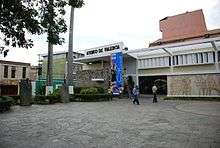
- Valencia Atheneum: a cultural centre where concerts and art exhibitions regularly take place.
- Municipal Theater of Valencia: It is the main theatre of Carabobo. It was finished in 1895 following the architecture of French theatres of the time.
- Theater Dr. Alfredo Celis Perez: It is the main amphitheater of the University of Carabobo. A much larger events facility called Aula Magna is currently under construction.
Museums
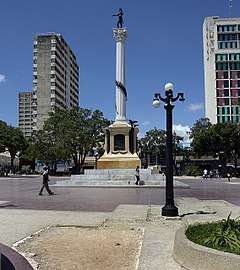
- Páez Mansion: this is a mansion once owned by one of the first presidents of Venezuela and leader of the independence wars, José Antonio Páez. It is currently a small museum and has a historical library. Some of the paintings with scenes depicting independence wars were made by Pedro Castillo, the grandfather of a well-known Venezuelan painter, Arturo Michelena.[10]
- Celis Mansion: this is a colonial house built in 1765. It is the seat of the Museum of Art and History and the Lisandro Alvarado Foundation.
- Museum of History and Anthropology: this museum contains an important collection of the pre-Columbian and colonial heritage of Venezuela.
- Iturriza Palace or Quinta Isabela: this has the Museum of the city (Museo de la Ciudad).
- 'Museum of Culture:' this museum holds different temporary arts exhibitions.
Parks and points of interest
- The Plaza Bolívar is noted for its monumental column surmounted by a statue of Simón Bolívar.
The square dates back to the colonial period, and was renamed after Bolivar in the nineteenth century. In 1887, Antonio Guzmán Blanco the president of Venezuela, decided to remodel the square, erecting a monumental column. The project was also endorsed by General Hermógenes López, president of Carabobo State, who succeeded Guzmán Blanco as president of Venezuela.
- Negra Hipólita Park and Fernando Peñalver Park: a large park with gardens, concert halls, cultural centres and facilities for children to learn traffic rules and celebrate parties. The park surrounds the stream of the Cabriales River in the Northern part of the city. The whole park is divided: the east side is the Negra Hipólita Park, and the west side is the Fernando Peñalver Park.
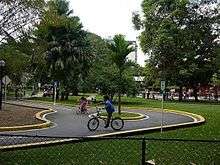
- Valencia's Metropolitan Park (Parque Metropolitano): a park on the Central part of the city with horses and large bird cages with a large variety of parrots. The park surrounds the stream of the Cabriales River in the Central part of the city.
- Humboldt Park (Parque Humboldt): a park on the Southern part of the city where the Museum of Culture is located. The park surrounds the stream of the Cabriales River in the Southern part of the city.
- Recreational Southern Park[11] (Parque Recreacional Sur): a park on the Southern part of the city where the Bull Ring is located, but also an area used for many concerts and national and international festivals and exhibitions.
- Valencia's Aquarium (Acuario de Valencia): Home to trained Amazon river dolphins, among many other species. It also contains also a serpentarium, a terrarium and a small zoo with many animals endemic to Venezuela. It also has some facilities for children to play.
- Plaza Monumental de Valencia: this is second largest bullring in the world and is located right in Valencia's Recreational Southern Park.
- Cerro Casupo Municipal Park: a natural park on the mountains, some 693 hectares big, to the Northwest of the city.[12]
Libraries
The main public library in Valencia is the Manuel Feo La Cruz Public Library, located in the city centre and open daily. Other public libraries are the Public Library of the Athenaeum of Valencia and the Morita Carillo Public Library, in the San Blas civic parish.
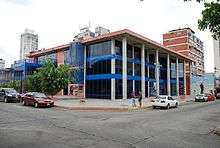
Transportation
The city is well connected with the rest of the country by a network of highways and roads maintained by INVIAL.
- Valencia counts with a modern subway system, Metro de Valencia. The first stage is already functioning, covering seven stations from the Southern part of the city to the downtown area. More stations are under construction and more lines are in planning stage.[13]
- Buses are the main means of mass transportation. There are two bus systems: the traditional system and the VALBUS. The traditional system runs a variety of bus types, operated by several companies on normal streets and avenues:
- bus; large buses.
- buseta; medium size buses.
- microbus or colectivo; vans or minivans.
- The airport, Arturo Michelena International Airport (violins), is the nation's third busiest. It is served by all major Venezuelan airlines, as well as a few international ones, and a large number of large cargo airlines.
Sports
Valencia is home of the Venezuelan LVBP baseball team Navegantes del Magallanes.
Other professional teams include Trotamundos de Carabobo (LPB basketball), Carabobo FC (FVF soccer), and Industriales de Valencia (volleyball).
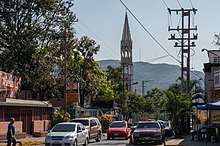
Notable natives
Beauty pageant winners
- Génesis Carmona (died in the aftermath of street protest gunshot wound to the head, 19 February 2014)
- Jacqueline Aguilera (Miss World 1995)
- Marena Bencomo (Miss Venezuela 1996)
- Carolina Indriago (Miss Venezuela 1998)
- Ly Jonaitis (Miss Venezuela 2006)
- Gabriela Isler (Miss Venezuela 2012, Miss Universe 2013)
- Thalía Olvino, (Miss Venezuela 2019)
- Michell Castellanos, (Miss Earth Venezuela 2019)
Composers and musicians
- Aldemaro Romero (1928–2007) pianist, composer, arranger and orchestral conductor
- Mirla Castellanos singer
Painters
- Arturo Michelena (1863–1898) painter
- Braulio Salazar (1917–2008) painter
- Angel Medina (1964 - present) rib painter
Politicians
- Francisco González Guinán (1841–1932) politician
- Guillermo Tell Villegas (1823–1907) former President of Venezuela
- Oscar Celli Gerbasi (1946-2016) Governor of Carabobo and President of Carabobo State Parliament
Athletes
- Álvaro Espinoza (born 1962) former shortstop in Major League Baseball
- Félix Hernández (born 1986) Major League Baseball starting pitcher for the Seattle Mariners.
- Francisco Cervelli (born 1986) Major League Baseball catcher for the Pittsburgh Pirates
- Henderson Álvarez (born 1990) Major League Baseball pitcher for the Miami Marlins
- Wilmer Flores (born 1991) major league baseball shortstop for the Arizona Diamondbacks.
- Cesar Hernandez (born 1990), second baseman for the Philadelphia Phillies.
- Roger Cedeño (born 1974) former Major League Baseball outfielder
- David Peralta (born 1987) Major League Baseball outfielder for the Arizona Diamondbacks.
- Salvador Pérez (born 1990) Major League Baseball catcher for the Kansas City Royals
- Edgar Duran (infielder) minor league shortstop in the Philadelphia Phillies organization
- Edward Mujica (born 1984) Major League Baseball Pitcher for the Boston Red Sox
- Eduardo Rodríguez (born 1993) Major League Baseball Pitcher for the Boston Red Sox
- Josef Martínez (born 1993) Major League Soccer striker for Atlanta United FC.
Entertainers
- Karen Hauer (born 1982), dancer and star of British television show Strictly Come Dancing
- Renny Ottolina (1928–1978) producer and entertainer
- Coraima Torres (born 1973) actress
- Luis Morillo (1981-2017) Musico y Maraquero de musica venezolana
Twinning
Valencia is twinned with:
References
- "History of Valencia (Spanish)". Archived from the original on April 6, 2008. Retrieved July 12, 2008.
- "Pre-Columbian history in Notitarde (Spanish)". Archived from the original on July 12, 2008. Retrieved July 12, 2008.
- Results for constitutional referendum in Valencia
- "Environmental report of the Faculty of Engineering" (PDF). University of Carabobo. Archived from the original (PDF) on October 3, 2008. Retrieved June 16, 2008.
- Proyección de la Población por municipios y parroquias del estado Carabobo, Universidad de los Andes
- Proyecciones Estados
- Artículo 7 – Gaceta Oficial del Estado Carabobo Extraordinaria No. 1633 (Abril 2004)
- El Carabobeño site
- Notitarde site
- Archived December 28, 2008, at the Wayback Machine Casa Páez
- "Archived copy". Archived from the original on September 1, 2011. Retrieved February 22, 2011.CS1 maint: archived copy as title (link)
- "Sitio del Cerro Casupo". Archived from the original on June 9, 2008. Retrieved June 13, 2008.
- http://www.metrovalencia.gob.ve
- "Ciudades Hermanadas con València" [Valencia Twin/Sister Cities]. Ajuntament de València [City of Valencia] (in Spanish). Archived from the original on October 29, 2012. Retrieved August 8, 2013.
External links
| Wikimedia Commons has media related to Valencia (Venezuela). |
